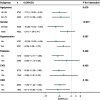Central adiposity and α-klotho: inflammatory mechanisms underlying aging biomarkers related to body roundness index
- PMID: 40211310
- PMCID: PMC11984050
- DOI: 10.1186/s12944-025-02541-6
Central adiposity and α-klotho: inflammatory mechanisms underlying aging biomarkers related to body roundness index
Abstract
Background: Obesity is a global health issue which has been widely accepted as an aging related pathogenesis. α-Klotho is a protein involved in aging process, mineral metabolism, insulin sensitivity, and the pathogenesis of various age-related diseases. Adiposity correlates with lower soluble α-Klotho, but the role of fat distribution and inflammation remains unclear. The body roundness index (BRI) refines central adiposity assessment beyond BMI. Herein, We aimed to investigate the relationship of BRI, inflammation and serum level of soluble α-Klotho.
Methods: We conducted a cross-sectional analysis of 9,958 U.S. adults (40-79 years) from the 2007-2016 NHANES. We examined association between BRI and serum α-Klotho (SαKl) levels, controlling for demographic, socioeconomic, lifestyle, and clinical factors. We also assessed whether inflammatory markers mediated the BRI-SαKl relationship.
Results: BRI was inversely associated with SαKl levels (P < 0.05). A significant sex interaction was found (P < 0.001), while BRI was positively correlated with multiple proinflammatory markers, which were all inversely related to SαKl levels. Mediation analyses showed inflammatory markers accounted for 20.5% (WBC), 18.0% (neutrophils), and 12.3% (platelets) of the BRI-SαKl association.
Conclusion: More severe central adiposity measured by BRI was related to lower SαKl, which may partly be attributed to inflammation. These findings underscore the importance of fat distribution and inflammation in obesity-related aging and may guide interventions to preserve SαKl levels. Longitudinal studies are needed to confirm causality and inform future strategies.
Keywords: Aging; Body roundness index; NHANES; Obesity; α−Klotho.
© 2025. The Author(s).
Conflict of interest statement
Declarations. Ethics approval and consent to participate: The survey was administered by the National Center for Health Statistics (NCHS) and approved by the NCHS Institutional Review Board (IRB). Informed consent was obtained from the eligible subjects before initiating the data collection and NHANES health examinations. All the authors confirmed that all the methods were carried out in accordance with the relevant NHANES Analytic Guidelines. Consent for publication: Not applicable. Competing interests: The authors declare no competing interests.
Figures


Similar articles
-
Establishment of sandwich ELISA for soluble alpha-Klotho measurement: Age-dependent change of soluble alpha-Klotho levels in healthy subjects.Biochem Biophys Res Commun. 2010 Jul 30;398(3):513-8. doi: 10.1016/j.bbrc.2010.06.110. Epub 2010 Jul 1. Biochem Biophys Res Commun. 2010. PMID: 20599764 Free PMC article.
-
Systemic immune-inflammation index mediates the association between abdominal obesity and serum klotho levels.Sci Rep. 2025 Feb 4;15(1):4205. doi: 10.1038/s41598-025-88015-2. Sci Rep. 2025. PMID: 39905076 Free PMC article.
-
Association between adult body shape index and serum levels of the anti-aging protein Klotho in adults: a population-based cross-sectional study of the NHANES from 2007 to 2016.Front Endocrinol (Lausanne). 2025 Feb 11;16:1424350. doi: 10.3389/fendo.2025.1424350. eCollection 2025. Front Endocrinol (Lausanne). 2025. PMID: 40007807 Free PMC article.
-
Association of body roundness index with cardiovascular disease in patients with cardiometabolic syndrome: a cross-sectional study based on NHANES 2009-2018.Front Endocrinol (Lausanne). 2025 Feb 3;16:1524352. doi: 10.3389/fendo.2025.1524352. eCollection 2025. Front Endocrinol (Lausanne). 2025. PMID: 39963283 Free PMC article. Review.
-
Inflammatory markers in population studies of aging.Ageing Res Rev. 2011 Jul;10(3):319-29. doi: 10.1016/j.arr.2010.11.002. Epub 2010 Dec 8. Ageing Res Rev. 2011. PMID: 21145432 Free PMC article. Review.
References
-
- Bluher M. Obesity: global epidemiology and pathogenesis. Nat Rev Endocrinol. 2019;15(5):288–98. - PubMed
-
- Rothman KJ. BMI-related errors in the measurement of obesity. Int J Obes (Lond). 2008;32(Suppl 3):S56-59. - PubMed
-
- Thomas DM, Bredlau C, Bosy-Westphal A, Mueller M, Shen W, Gallagher D, Maeda Y, McDougall A, Peterson CM, Ravussin E, et al. Relationships between body roundness with body fat and visceral adipose tissue emerging from a new geometrical model. Obesity (Silver Spring). 2013;21(11):2264–71. - PMC - PubMed
-
- Rico-Martin S, Calderon-Garcia JF, Sanchez-Rey P, Franco-Antonio C, Martinez Alvarez M, Sanchez Munoz-Torrero JF. Effectiveness of body roundness index in predicting metabolic syndrome: A systematic review and meta-analysis. Obes Rev. 2020;21(7): e13023. - PubMed
MeSH terms
Substances
LinkOut - more resources
Full Text Sources
Medical

